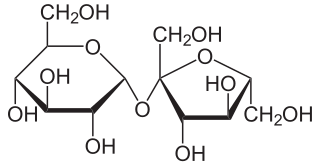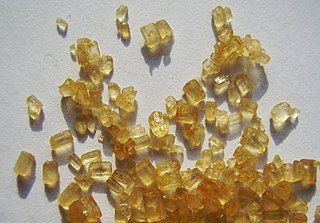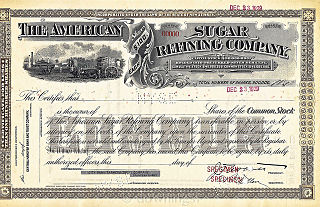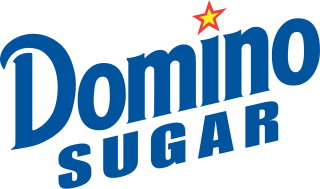
A sugar beet is a plant whose root contains a high concentration of sucrose and which is grown commercially for sugar production. In plant breeding, it is known as the Altissima cultivar group of the common beet. Together with other beet cultivars, such as beetroot and chard, it belongs to the subspecies Beta vulgaris subsp. vulgaris but classified as var. saccharifera . Its closest wild relative is the sea beet.

Sucrose, a disaccharide, is a sugar composed of glucose and fructose subunits. It is produced naturally in plants and is the main constituent of white sugar. It has the molecular formula C
12H
22O
11.

Crockett is a census-designated place (CDP) in Contra Costa County, in the East Bay sub-region of the San Francisco Bay Area, California. The population was 3,094 at the 2010 census. It is located 28 miles northeast of San Francisco. Other nearby communities include Port Costa, Martinez, Vallejo, Benicia, Rodeo, Hercules, Pinole and Richmond.

A refinery is a production facility composed of a group of chemical engineering unit processes and unit operations refining certain materials or converting raw material into products of value.

Brown sugar is a sucrose sugar product with a distinctive brown color due to the presence of molasses. It is by tradition an unrefined or partially refined soft sugar consisting of sugar crystals with some residual molasses content, but is now often produced by the addition of molasses to refined white sugar.

Adolph Claus J. Spreckels was a major industrialist in Hawai'i during the kingdom, republican, and territorial periods of the islands' history. He also involved himself in several California enterprises, most notably the company that bears his name, Spreckels Sugar Company.

A sugar refinery is a refinery which processes raw sugar from cane or sugar extracted from beets into white refined sugar.

Golden syrup or light treacle is a thick, amber-coloured form of inverted sugar syrup made by the process of refining sugar cane or sugar beet juice into sugar. It is used in a variety of baking recipes and desserts. It has an appearance and consistency similar to honey, and is often used as a substitute where honey is unavailable.
Alexander & Baldwin, Inc. is an American company that was once part of the Big Five companies in territorial Hawaii. The company currently operates businesses in real estate, land operations, and materials and construction. It was also the last "Big Five" company to cultivate sugarcane. As of 2020, it remains one of the State of Hawaii's largest private landowners, owning over 28,000 acres (11,000 ha) and operating 36 income properties in the state.
The Spreckels Sugar Company is an American sugar beet refiner that for many years controlled much of the U.S. West Coast refined sugar market. It is currently headquartered in Brawley, California.

The American Sugar Refining Company (ASR) was the largest American business unit in the sugar refining industry in the early 1900s. It had interests in Puerto Rico and other Caribbean locations, and operated one of the world's largest sugar refineries, the Domino Sugar Refinery in Brooklyn, New York.
British Sugar plc is a subsidiary of Associated British Foods and the sole British producer of sugar from sugar beet, as well as medicinal cannabis.

Domino Foods, Inc. is a privately held sugar marketing and sales company based in Yonkers, New York, United States, that sells products produced by its manufacturing members. DFI distributes sugar to retailers under four brand names across the U.S: Domino,C&H,Florida Crystals, and Redpath. Its namesake product, the Domino Sugar brand name, whose products are generally sold in two-tone packaging with blue labeling text, is the best known. Domino Foods is the largest sugar company in the United States.
The Amalgamated Sugar Company is an American sugar beet-refining company run on a cooperative basis. It was founded in 1897 in Ogden, Utah, and is now located in Boise, Idaho. The company markets its sugar under the White Satin brand.

American Sugar Refining, Inc. is a large privately held cane sugar refining company, with a production capacity of 6.5 million tons of sugar. The company produces a full line of consumer, industrial, food service, and specialty sweetener products. In 2013, it adopted the corporate brand name ASR Group. Its ownership structure is based on a partnership which includes the Florida Crystals Corporation, part of FLO-SUN, a sugar empire of the Fanjul brothers whose origins go back to Spanish-Cuban sugar plantations of the early 19th century.
BASF Plant Science is a subsidiary of BASF in which all plant biotechnology activities are consolidated. The company was founded in 1998 and employs approximately 700 people at 6 different locations worldwide. The headquarters of BASF Plant Science is located in Research Triangle Park and has research sites in the US, Canada, and Europe. The company mainly develops genetically modified seeds at these locations.
Sugar Cane Growers Cooperative of Florida is a vertically integrated agricultural enterprise that harvests, transports and processes sugarcane grown primarily in Palm Beach County, Florida and markets the raw sugar and blackstrap molasses through the Florida Sugar and Molasses Exchange. The Cooperative is made up of 45 grower-owners who produce sugarcane on approximately 70,000 acres of some of the most fertile farmland in America, located in the Everglades Agricultural Area (EAA). Sugarcane grown by Cooperative members is harvested, transported and processed. The raw sugar is then marketed to one of the ASR Group's sugar refineries. The Cooperative produces more than 350,000 tons of raw sugar annually.
A genetically modified sugar beet is a sugar beet that has been genetically engineered by the direct modification of its genome using biotechnology. Commercialized GM sugar beets make use of a glyphosate-resistance modification developed by Monsanto and KWS Saat. These glyphosate-resistant beets, also called 'Roundup Ready' sugar beets, were developed by 2000, but not commercialized until 2007. For international trade, sugar beets have a Maximum Residue Limit of glyphosate of 15 mg/Kg at harvest. As of 2016, GMO sugar beets are grown in the United States and Canada. In the United States, they play an important role in domestic sugar production. Studies have concluded the sugar from glyphosate-resistant sugar beets is molecularly identical to and so has the same nutritional value as sugar from conventional (non-GMO) sugar beets.
The sugar industry of the United States produces sugarcane and sugar beets, operates sugar refineries, and produces and markets refined sugars, sugar-sweetened goods, and other products. The United States is among the world's largest sugar producers. Unlike most other sugar producing countries, the United States has both large and well-developed sugarcane and sugar beet industries. Refined sugarcane, processed sugar beet, and high-fructose corn syrup are all commonly used in the U.S. as added sugars to sweeten food and beverages.

A beet sugar factory or sugar factory, is a type of sugar production facility that produces sugar from sugar beet. Nowadays most sugar factories also act as a sugar refinery. The first beet sugar factory was founded in 1802.












